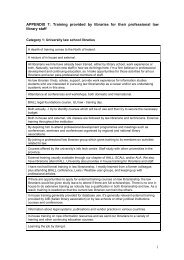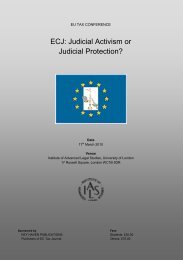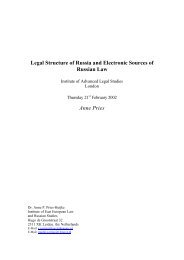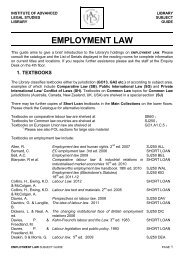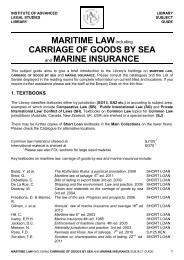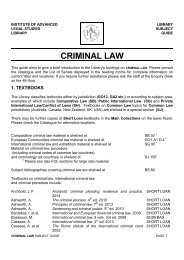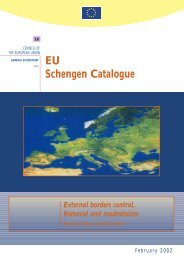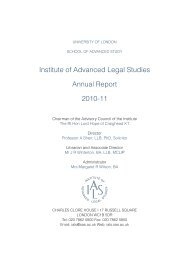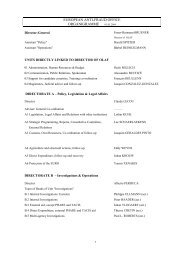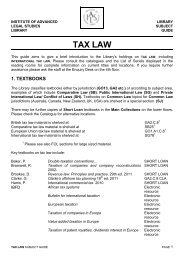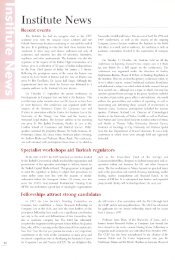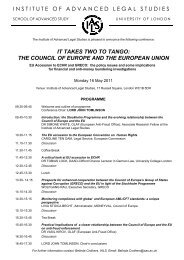a thesis - Institute of Advanced Legal Studies
a thesis - Institute of Advanced Legal Studies
a thesis - Institute of Advanced Legal Studies
Create successful ePaper yourself
Turn your PDF publications into a flip-book with our unique Google optimized e-Paper software.
50 EXPEESS TRUSTS.<br />
whether the settlor himself could have revoked the trust before his<br />
death was expressly left open. (See p. 503 <strong>of</strong> the report.)<br />
There is a decision <strong>of</strong> In re Sander's Trusts (1878, 47 L. J. Ch.<br />
667) which conflicts with these, but it seems to be the only case in<br />
conflict with what has been said, and must, having regard to the<br />
weight <strong>of</strong> authority against it, be considered <strong>of</strong> doubtful authority.<br />
Illustration.<br />
By deed <strong>of</strong> " family arrangement" made by A. and B. (father<br />
and son) in 1867, an estate is limited to A. for life, with remainder<br />
to trustees upon trust with consent <strong>of</strong> A. and B. during their joint<br />
lives, or <strong>of</strong> the survivor, and after the death <strong>of</strong> the survivor at the<br />
discretion <strong>of</strong> the trustees to sell and apply the proceeds in payment<br />
as therein mentioned <strong>of</strong> all debts owing by A.; and subject thereto<br />
to hold any unsold hereditaments to the uses <strong>of</strong> a deed <strong>of</strong> even date<br />
under which A. and B. are successive tenants for life with remainder<br />
to an infant son <strong>of</strong> B. in tail. A.'s creditors are neither parties to<br />
nor named in the deed, nor is it ever communicated to them.<br />
After A.'s death the trustees sell part <strong>of</strong> the estate with B.'s consent,<br />
and out <strong>of</strong> the proceeds pay all A.'s debts except one due to<br />
X. (A.'s sister), <strong>of</strong> which they are unaware. In 1889 the trustees,<br />
with the concurrence <strong>of</strong> B. (who is A.'s executor), convey the<br />
unsold property to the uses <strong>of</strong> the second deed <strong>of</strong> 1867. B. cannot<br />
revoke the trust, and the infant tenant in tail takes the property<br />
subject to the liability for the debt due to X. Priestley v. Ellis,<br />
(1897) 1 Ch. 489.<br />
(d) When an intention to create a trust otherwise appears.—In<br />
Wilding v. Richards (1845,1 CoU. Ch. E. 655), Knight Bruce, V.-C.,<br />
while admitting that if an instrument in favour <strong>of</strong> creditors,<br />
though in form a trust, is intended to be a mere instrument <strong>of</strong><br />
agency, the intention must have effect given to it, went on to say<br />
that it is not every deed in favour <strong>of</strong> creditors to which no creditor<br />
is a party that is <strong>of</strong> that description; the Court in each case must<br />
be guided by the particular circumstances. Again, in Smith v.<br />
Hurst (1852, 10 Hare, 30), Turner, Y.-C., said in cases <strong>of</strong> deeds<br />
purporting to be executed for the benefit <strong>of</strong> creditors, and to which<br />
no creditor is a party, the motive <strong>of</strong> the party executing the deed<br />
may have been either to benefit his creditors or to promote his own<br />
convenience; and the Court there has to examine into the circum-



